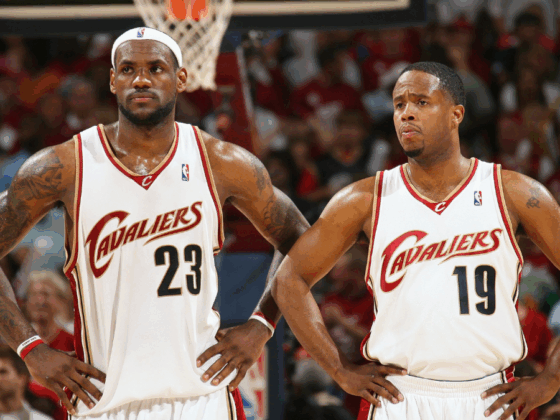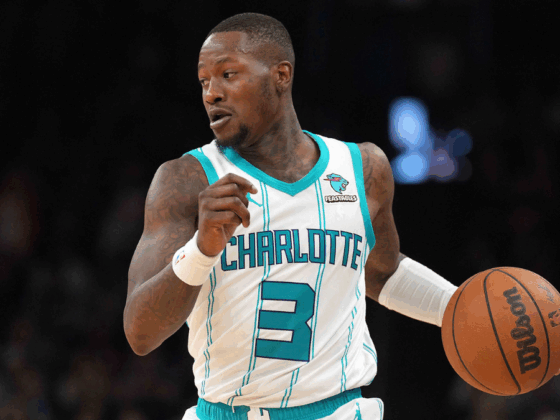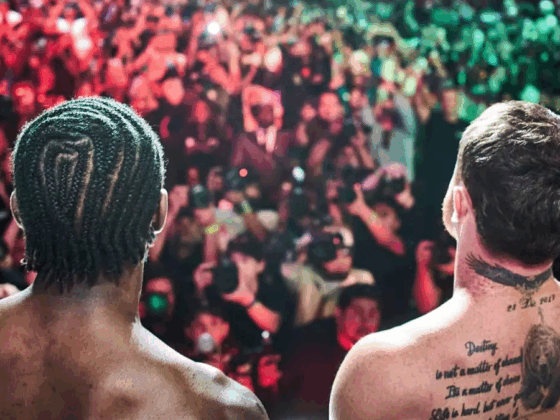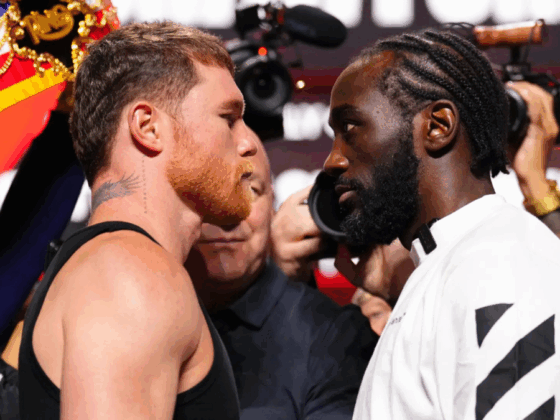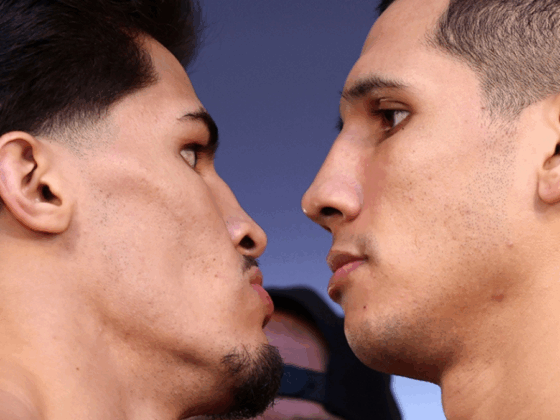
The Celtics’ Jayson Tatum, Sixers’ Ben Simmons and Donovan Mitchell of the Utah Jazz all enter the 2018 NBA playoffs with unreasonable burdens and expectations. Just how historic has this rookie class been, and what should we expect from them in the postseason?
Rookies playing big roles on playoff teams isn’t entirely unprecedented. Magic Johnson, in his first year in the NBA, famously notched 42 points, 17 rebounds and 7 assists filling in for an injured Kareem Abdul Jabbar in game seven of the 1980 finals, arguably the greatest finals’ performance of all-time given the circumstances. Magic set an unreachable standard for rookie excellence. While no individual rookie is ever likely to top what Magic did that year, the 2017-18 NBA rookie class has been pretty damn special in their own right.
It’s been a contentious year in many spheres of life, but none more so than the race for the NBA’s rookie of the year award. Ok, not really. But it’s been combative, to say the least. As if the fans weren’t bad enough, now the players themselves are getting in on the debate. I’m not going to give my pick ROY just yet (I’ll keep my social-media sanity for another few days) but Ben Simmons appears to be on course to win the award. Who knows, maybe he and main competition Donovan Mitchell will join Elton Brand/Steve Francis and Jason Kidd/Grant Hill as the only guys to share the award.
A silly award aside, there are tons of interesting questions to be asked of this rookie class. Three players will enter the playoffs with far more responsibility than should reasonably be expected: the aforementioned Simmons and Mitchell, as well as Boston’s Jayson Tatum. Just how historic are these guys? What can be gleaned from their play in the clutch this year?
Jayson Tatum

Danny Ainge is a compulsive liar. The best GMs generally are, at least when they’re speaking in public. Ainge’s draft-night assertion, that he would’ve taken Tatum first overall no matter what was met with nudge-nudge giggles. Tatum was good. He wasn’t the type of dynamic, can’t-miss prospect that Fultz was. Tatum has dealt with questions of how good he really is since the start of his freshman year in college. Scouts saw the one-on-one scoring ability, but he wasn’t good enough spotting-up they said.
When Tatum burst out of the gates shooting a barely believable 50% from three over the season’s first two months, the naysayers came from all fronts. Small-sample-size twitter cried foul. It won’t hold up. His detractors seemed to be right when Tatum hit the rookie-wall hard in January, shooting 34 percent from deep. It seemed the emperor had no clothes after all.
Not quite. Tatum has rallied since that shaky start to the new year. He’s shooting 42.5 percent since the beginning of February. It’s true that multiple seasons are needed before we can really believe in the efficacy of a players’ shooting. Still, no matter which way you slice it, Tatum has been historically efficient as a rookie. In NBA history, there have been 297 rookie seasons in which a player suited up for at least 65 games and shot at least 10 times per contest. Of those 297 seasons, Tatum has the ninth-highest true-shooting percentage (58.8 percent), the fortieth-best win-shares per/48 (.140) and is the only player to shoot at least forty-one percent from three (43.1 percent).
Other critics claimed Tatum was nothing more than a by-product of Brad Stevens’ coaching and the Celtics’ system. “He doesn’t have to do much” was the common refrain. There was a certain amount of truth to this claim for the bulk of the season, but its foundations have been rocked over the last month. A rash of injuries late in the season has bumped the former Blue-Devil into an even more prominent role, particularly in the twelve games since star point-guard Kyrie Irving went down with a knee injury that could threaten Boston’s season. The Celtics are 7-5 in those games, with Tatum averaging 17.5 points (on 12.9 shots) to go along with 5.1 rebounds and 2.1 steals per contest.
Tatum has (justifiably) been on the periphery of the rookie-of-the-year race, mainly because he wasn’t doing the same type of heavy-lifting guys like Mitchell and Simmons were. It’s too late for a push into that conversation, but the young wing is definitely showing what he’s capable of with more responsibility and touches. With Irving set to miss the playoffs, the pressure and responsibility will be ratcheted-up even further. Terry Rozier is a fine replacement for Irving. Jaylen Brown is an effective spot-up shooter who can get out on the break. Al Horford is a master of ball-movement. None of these guys can create the way Tatum can.
Boston’s offense has sputtered at the best of times. The Celtics’ savvy passing and significant coaching advantage will create buckets. Half-court slogs seem like an inevitability, though. Iso-ball is a filthy concept in the age of ball-movement and egalitarian offense (though the Houston Rockets are currently tearing up everything we think we know about isolation efficiency). Still, it’s incredibly useful in the tenser moments of playoff basketball.
Clutch Play and Role
Amazingly, Tatum has used more possessions in clutch situations than Ben Simmons, but isn’t even in the same atmosphere as Mitchell:
Usage % Turnover % Minutes
Donovan Mitchell 44% 48.1.% 102
Jayson Tatum 21.9% 34.3% 144
Ben Simmons 19.0% 20.4% 147
A Gobert-less stretch from the 16th of December to the 16th of January explains the disparity in total minutes (you’re not going to play many close games when you’re getting blown out by 11.2 points per 100 possessions every night). Mitchell’s usage rate is phenomenal and only matched league-wide by guys like LeBron, James Harden and Russell Westbrook. Mitchell enjoys the confidence of his coach and isn’t short on confidence in himself. I’ll come back to him later.
It’s interesting to note that Tatum’s percentage in the clutch is significantly higher than his rate on the season (19.3 percent), and much closer to his rate over the last 15 games as injuries started to rampage through the squad (24.1 percent). Tatum’s skill with the ball, length, size and finishing ability around the rim make him a much more effective option against half-court defenses, and that’s usually what close-games devolve into. Tatum had an uneven performance against the Wizards in an overtime thriller, but he flashed some of that ability to score under-pressure that will be invaluable come playoff time. Watch him feel Bradley Beal over-commit on his right side, spin, take two giant strides before laying the ball up beautifully:
Again, one week later in a big win over the Thunder. A beautiful step-back three that would have James Harden swaggering:
Some have speculated that Tatum’s shooting-slump from Christmas through the end of January was related to an injury to his pinky finger. Maybe. Any effect it had on his handle appears to be anecdotal, as his turnover percentage remained fairly steady.
Passing is the weakest aspect of Tatum’s game and the source of a large portion of his clutch turnovers. Defenders are able to telegraph passes easily when he starts dithering with the ball:
It takes some guys a little longer to adjust to NBA passing angles. The sheer length and athleticism on the court every night is jarring, and a big part of why rookie point-guards often take longer to develop than guys at other positions. Superstar talents like Kevin Durant and Kawhi Leonard took several seasons to become average passers at their position. Tatum should get there with time. Playoff defenses are remorseless and will laser in on any perceived weakness like a pack of hyenas. Tatum will receive more attention on the offensive end that ever could have been anticipated back in September. Learning how to pass out of double and triple-teams is just one more hurdle for the young wing to jump.
Ben Simmons

Pending the results of surgery, Embiid could return to play in 2-4 weeks, per league source. First round obviously in some jeopardy.
— Zach Lowe (@ZachLowe_NBA) March 30, 2018
Well, this sucked. The superstar injury wave hasn’t crested just yet. An inadvertent knock with Fultz (playing in just his second game with the team since October) fractured Embiid’s orbital bone. The great popstar-botherer is almost certainly going to miss at least some of the first round of the postseason. Suddenly, the training wheels are off. Simmons has responded with the strongest run of play of his young career. The former number-one-pick has averaged a triple-double (round numbers!) during the Sixers 15-game winning-streaks, an amazing seven of which have come without their gargantuan franchise-talisman.
While the schedule has been mostly cupcakish (I swear, it’s a word), Simmons has taken on the role of leader admirably. Part of what makes guys like James Harden and Chris Paul so devastating as offensive coordinators is their innate understanding of timing, space and movement. Lean the wrong way, betray your intentions with footwork and you’ll be punished. Simmons is in that tier.
It has long been my contention that decision-making is one of the most undervalued traits in professional basketball. Simmons’ instincts are impeccable. Beautiful look-away passes on the break are common. Touch passes are delivered with breath-taking ease:
Simmons’ rookie year is a microcosm of the Sixers’ season as a whole; far beyond anything, even the most blinded fan, could have expected. His stats are incredible. He’s defending everyone from point-guards to centers. Passes are flung from all angles with LeBron-esque flair and precision. The team has the second-best record in the league since January first (34-11). Their point-differential over the same period is at an all-time-great level (plus 9.0).
The Sixer’s Embiid-less minutes aren’t quite the train-wreck they were in the season’s opening months. Simmons has played 602 minutes without #theprocess since February 1st. The team has a plus 9.7 net-rating in those minutes. Open shots aren’t as easy to find without Embiid’s gravity sucking players into the paint. Efficiency numbers drop. But the team is starting to find a rhythm when one of the most imposing players in recent history steps off the floor.
The Sixers might be the most-unique team in NBA history. The team’s two best players have logged just 173 games combined. The 2009-2010 OKC Thunder have been held up as their best historical analogue, but Russell Westbrook and Kevin Durant were practically grizzled veterans by comparison. Russell Westbrook alone had logged 164 games by the time the postseason rolled around (his snarl had logged 321, per basketball-reference). The team faces many of the same questions the Celtics are dealing with: What will these young studs look like when the lights are shining brightest?
Playoff Translation
Simmons is having a historic regular season, not just by rookie standards. The only players in NBA history who have matched his per-game stats (16 points, 8 assists, 8 rebounds and 1.5 steals) are sure-fire hall-of-famers: Michael Jordan, Magic Johnson and Russell Westbrook. Simmons fills-gaps for the Sixers in a very Magic-like way, providing the team with whatever it needs on a given night. I would personally bristle at the notion of ranking Simmons in the league’s top 20 players just yet, regardless of how good he’s looked in the regular season, mainly because we have no idea what he will look like in the playoffs.
Embiid’s broken face is a major issue, but the real elephant in the room (with the potential to make-or-break the Sixers’ season) is Simmons’ jumper. Or lack of a jumper.
The problems Simmons’ absent outside-game could create were on full display in a close-win over LeBron James and the Cavs on April sixth. The lack of viable rim-protection on a team like the Cavs makes Simmons ability to build up steam and get into the chests of defenders even more dangerous, but plays like the following are worrisome. The complete indifference to Simmons on the perimeter is jarring as four Cav defenders box-out the paint. Redick was able to bail the play out with a baseline jumper as the clock expired:
Ironically, packing-the-paint in such fashion was the strategy which undid LeBron himself when the King faced off against the Gregg Popovich and the Spurs in his first NBA finals back in 2007. The Spurs backed several feet off LeBron on every possession, stymying his drives and making it next to impossible for him to score efficiently. Though he still put up stats across-the-board, James averaged just 22 points on 35.6 percent shooting as the Spurs brought out their brooms and dismantled the Cavs in just four games. That series was the catalyst for five years of some of the toughest criticism any superstar has ever faced in the game of basketball.
Simmons’ ability to make reads a fraction of second quicker than 99 percent of the league will help. His combination of height, intellect and accuracy puts him in that LeBron/Magic category of superstar, one who can make an impact on most nights without having to stretch the floor. Even without Embiid, this current Sixers squad is infinitely more dynamic, diverse and better-coached than any of those late-2000s Cav teams.
Donovan Mitchell

It’s easy for fans with a rooting interest in Simmons or Tatum to denigrate Donovan Mitchell as “just” a scorer. It’s true, he shoots a lot. Context: He’s tasked with doing so. The Utah Jazz had a gaping hole in their offense following Gordon Hayward’s departure. Head coach Quin Snyder handed the keys to the offense over to the 13th overall pick in the draft. It was a decision which could have backfired. Snyder was struck with how mature the young guard was, how open to constructive criticism. Speaking with ESPN’s Tim Mahon back in December, Snyder beamed “You trust him because he cares and wants to improve.”
Mitchell will finish the season as the first rookie to lead a playoff team in scoring since Carmelo Anthony in 2003-2004. There have been 45 twenty-points-per-game rookie seasons in NBA history. Of those 45, the only guards with a higher true-shooting percentage than Mitchell (54.2 percent) are Michael Jordan (59.2 percent) and Oscar Robertson (55.5 percent). In fact, even though his raw field-goal percentage is significantly lower than Simmons’, the difference in true-shooting is relatively small
The Jazz have played the second-fewest clutch minutes of any team in the league (107 total, tied with the Houston Rockets). Mitchell has predictably featured very prominently on the offensive end, accounting for 94 of the Jazz’s 260 clutch points on below-average efficiency (49.9 true-shooting percentage). Mitchell is significantly less-efficent than both Simmons (65 percent true-shooting) and Tatum (67.7 percent true-shooting). Amazingly, Mitchell (85) has taken fifty more clutch shots than Simmons (35) and 34 more than Tatum (51). Here’s Mitchell’s clutch shot-chart, per NBA stats and info.

There are plenty of reasons for his relative inefficiency shooting the ball. For all the Jazz’s egalitarian wonderfulness, elite off-the-bounce shot-creation is still important. Really important. Mitchell is the team’s only option in that regard, and it’s a burden not meant for slightly undersized rookies.
Inside and Out
Finishing at the rim is where the Spider really shines. Mitchell is Kemba Walker-like in his ability to split traps, keep his dribble low to the ground and storm towards the basket. Rudy Gobert and Derrick Favors are two of the best screen-setters in the league. Mitchell navigates them with the controlled explosion of a much more experienced player. It generally doesn’t matter which defender stands in his path, Mitchell will find a way to gather the ball and finish:
Shots away from the basket have yielded mixed results. Mitchell loves difficult shots, particularly those deep pull-up threes. Mitchell is shooting a very respectable 40.6 percent on catch-and-shoot threes, but just 29.3 percent on the pull-up variety (3.9 attempts per game). Mitchell’s stroke is beautiful. The safe bet is he develops an effective pull-up three. It isn’t there just yet.
Rookies are generally worse decision-makers than veterans. Obviously. Learning how to delineate between good shots and bad ones is difficult. It takes a while to understand what you can do and what you can’t, how to recognize what to do in certain situations against different personnel. Mitchell’s decision-making has evolved since the beginning of the season, but it still isn’t perfect.
Stepping into a Steph-Curry (all rights reserved) with Andre-fricking-Roberson hanging around? Generally not smart. Stepping into a three when you have LaMarcus Aldridge on an island and an open lane? Ditto.
The Dwyane Wade comparison is an easy one to make. Mitchell’s herky-jerky driving style, impeccable footwork and beautiful, full-extension finishes are eerily reminiscent of South Beach’s favorite son. Though he was picked fifth overall, Wade flew under-the-radar as the media fawned over LeBron James and Carmelo Anthony. Within a few years, it was clear he was the second-best player in a historical draft. Mitchell, the 13th pick overall last year, appears to be on a similar trajectory*.
*NOTE: Memories are short, and it was long enough ago that younger fans might not be aware, but Wade was beyond good in the playoffs as a rookie. He hit a fricking game-winner in his first ever playoff game (a series the Heat eventually won in seven games). The Heat then went on to scare the wits out of the 61-win Indiana Pacers team in the second-round, pushing the number-one seed to six games as Wade put up 21 points a night on 48.9% shooting. It speaks volumes that were Mitchell to have a similar coming-out party, not one eyebrow would be raised on my part.
The Future of Rookie Evaluation
The bar has been raised. The standard set by the 2017 class will be the bane of every underwhelming rookie for years. Even beyond the obvious stars, guys like OG Anunoby, Bam Adebayo and Zach Collins are playing meaningful minutes for really good teams. It’s unreasonable to expect every rookie to head the ground running. For every Jayson Tatum there’s a Josh Jackson. For every Ben Simmons there’s a De’Aaron Fox. Guys like Jackson and Fox have shown flashes of putting it together (in some pretty bad situations) and are much more reflective of the average developmental trajectory of young, raw products entering the most competitive basketball league in the world.
Fans of Simmons, Mitchell and Tatum are as rabid and irrational as any in the league. All three players should be given credit for how well they’ve performed, but one has to remember just how lucky each guy is. The Jazz, Sixers and Celtics are all first-rate organizations with great coaching, culture and top-end talent. Most rookies are drafted into polar-opposite situations. Enjoy the greatness, folks. Just don’t expect lightning to strike twice.

